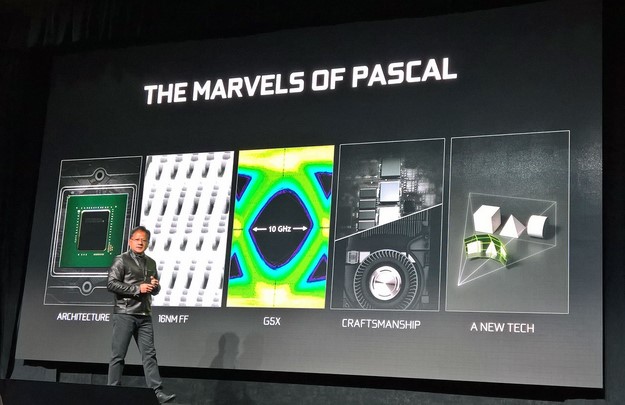 NVIDIA GeForce GTX 1080 - Faster Than Titan X For Half The Cost, Faster Than 2x GTX 980
NVIDIA GeForce GTX 1080 - Faster Than Titan X For Half The Cost, Faster Than 2x GTX 980
Tonight at an event in Austin, Texas, NVIDIA unveiled its highly anticipated next-generation, Pascal-based GeForce graphics cards, known as the GeForce GTX 1080 and GeForce GTX 1070. NVIDIA’s
Pascal architecture is based on 16nm FinFET technology, similar to that of NVIDIA’s high end data center
Tesla P100 processing engine, but the GeForce cards are targeted at the consumer gaming market. NVIDIA’s GP104 GPU at the heart of the new GeForce cards is comprised of some 8 billion transistors and features a 256-bit memory interface and 8GB of Micron GDDR5X graphics memory -- commonly referred to as G5X -- or 8GB of standard GDDR5 in the case of the GTX 1070.
At the event, NVIDIA CEO Jen-Hsun Huang proclaimed the new cards were the result of "several billions of dollars of R&D" expenditure and that they took over two years of development effort by thousands of engineers.
Along with the new graphics cards, NVIDIA unveiled multiple new technologies as well, including what the company refers to as the world's first "in-game 3D VR camera system," called Ansel, in addition to new VR audio technology called VRWorks Audio that leverages technology from NVIDIA's iRay physically based rendering tech (part of
NVIDIA's VRWorks suite) and something called Simultaneous Multi-projection technology that presents aspect-correct and distortion-free multi-monitor rendering and VR imaging delivered through multiple viewports, that can be rendered in a single-pass with no performance penalty.

NVIDIA's tech demo's are always impressive. The Simultaneous Multi-Projection technology in particular was a dramatic demonstration as 360-degree views were rendered in real-time without warping of the peripheral images as the user panned their head and altered the camera view. And enabling the single-pass rendering dramatically improved performance from roughly 65-68 frames per second, to 96 FPS. However, the big splash of course was the unveiling of
the GeForce GTX 1080 which was claimed to be faster than a pair of
GeForce GTX 980 cards in SLI and offer 9 TFLOPS of throughput, all without the usual sticker shock associated with a very high-end GPU at a $599 MSRP, or $699 for a Founders Edition which will reportedly be highly overclockable.


Huang also demonstrated the new GeForce GTX 1080 in action with his frequent game developer partner, Epic's Tim Sweeney. The GeForce GTX 1080 powered a demo that featured highly-realistic, complex characters, with impressive lighting and material effects that were rendered in real-time. During the demo, the GTX 1080's GPU clock hit a blistering 2.1GHz with a 5.5GHz G5X memory clock. The new GeForce was also humming along at a tepid 67ºC.
 Epic's Demo Running On A NVIDIA GeForce GTX 1080 With A 2.1GHz GPU Core Clock
Epic's Demo Running On A NVIDIA GeForce GTX 1080 With A 2.1GHz GPU Core Clock
Huang went on to quickly announce a lower cost and equally as impressive
Pascal-based GeForce called the GeForce GTX 1070, which will offer about 70+ percent of the performance of the GeForce GTX 1080 or about 6.5 TFLOPS of compute throughput, for a very attractive mid-range price point of $379.
NVIDIA's GeForce GTX 1080 and GTX 1070 announcement this evening were a very quick, opportune "mic drop" of sorts, strategically positioned to coincide with the Austin DreamHack LAN gaming event, where thousand of gamers have converged on the city for a BYOC (Bring Your Own Computer) gaming fest of epic proportions.
The new NVIDIA GeForce GTX 1080 will start shipping in market at the end of the month on May 27th, while the GeForce GTX 1070 is due to arrive on June 10. You can expect the usual AIB partners like EVGA, ASUS, Gigabyte, MSI and PNY to deliver various offerings, both based on the stock reference designs and with their own custom cooling solutions as well, in the months ahead.








